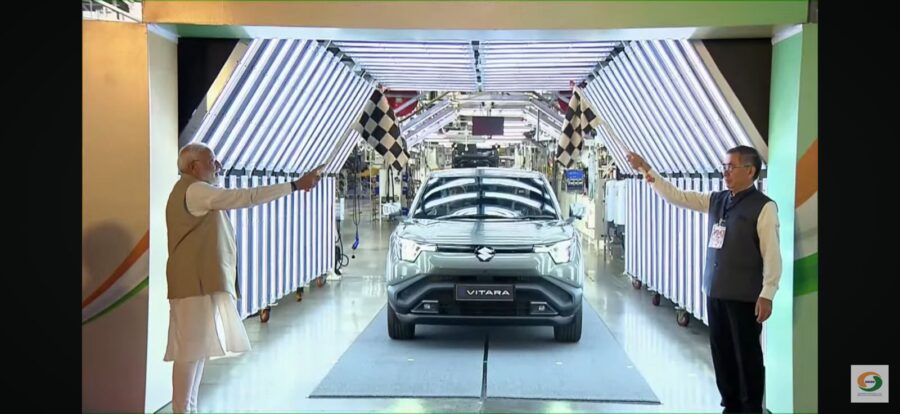On August 26, 2025, Prime Minister Narendra Modi flagged off the Maruti Suzuki e-Vitara, the company’s first Battery Electric Vehicle (BEV), at its Hansalpur plant in Gujarat. This event marks a significant step in India’s journey toward becoming a global hub for electric vehicle (EV) manufacturing, aligning with the “Make in India, Make for the World” initiative. The e-Vitara, designed for both domestic and international markets, will be exported to over 100 countries, including advanced markets like Japan and Europe, showcasing India’s growing prowess in green mobility.

The e-Vitara stands out due to its innovative platform, developed collaboratively by Suzuki, Toyota, and Daihatsu, with Suzuki leading the charge. Built on the Heartect-e skateboard architecture, the vehicle integrates a battery and e-axle system tailored for global standards, meeting stringent EuroNCAP, ASEAN NCAP, and Japanese crash requirements. Available in 49 kWh and 61 kWh battery variants, with front-wheel-drive and all-wheel-drive (AllGrip) options, the e-Vitara offers a claimed range of up to 500 km. It will also be rebadged as Toyota’s Urban Cruiser EV, amplifying its global reach.
What makes this launch a “Make in India” milestone is not just the vehicle but the ecosystem behind it. The Hansalpur plant, alongside the TDSG (Toshiba Denso Suzuki Gujarat) facility, now produces over 80% of the battery value locally, reducing reliance on imports and strengthening India’s EV supply chain. This localization of critical components like lithium-ion battery cells and electrodes for hybrid vehicles underscores the push for self-reliance under Aatmanirbhar Bharat. Maruti Suzuki’s ₹70,000 crore investment plan over the next five to six years further signals its commitment to scaling production to 4 million units by 2030, with India as its global EV hub.

However, the e-Vitara’s significance goes beyond numbers. While competitors like Tata Motors and Mahindra are still developing their export strategies, Suzuki’s ability to penetrate markets like the UK, Germany, and Japan highlights a strategic edge. Yet, questions remain. Maruti’s late entry into the EV space, in a price-sensitive Indian market with patchy charging infrastructure, could challenge domestic adoption. The multi-powertrain approach—EVs, hybrids, ethanol flex-fuel, and biogas—reflects pragmatism but may dilute focus. Moreover, the timing of the export launch coincides with potential trade hurdles, such as the reported 50% U.S. tariff threat due to India’s oil purchases from Russia, which could complicate global ambitions.
The e-Vitara echoes the legacy of the Maruti 800, which democratized mobility in the 1980s. Today, it aims to make clean mobility accessible while positioning India as a serious player in the global EV race. Whether it can replicate the Maruti 800’s transformative impact depends on infrastructure growth, consumer trust, and Maruti’s ability to balance affordability with innovation. For now, the e-Vitara is a bold statement of India’s manufacturing potential, blending swadeshi pride with global aspirations.

